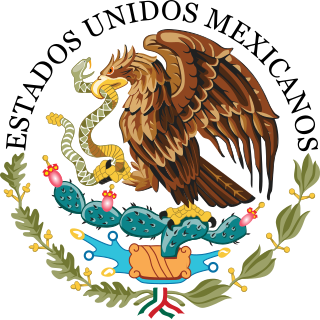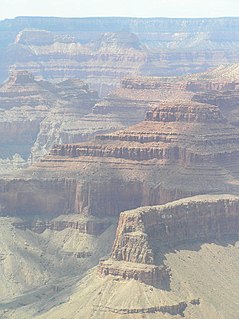
This is a table of the ranks and insignia of the Mexican Army. Spanish language ranks are in italics, with English translations. Rank insignia of the Mexican Air Force and Mexican Army are identical, as are the ranks, with the exception of two general ranks. Currently the ranks are supported with the Fuerza Aérea ranks for the air force itself only, with special titles in the army for all ranks per their respective specialty.
Taupe is a dark brown color between brown and gray. The word derives from the French noun taupe meaning "mole". The name originally referred only to the average color of the French mole, but beginning in the 1940s, its usage expanded to encompass a wider range of shades.

The family Mormoopidae contains bats known generally as mustached bats, ghost-faced bats, and naked-backed bats. They are found in the Americas from the Southwestern United States to Southeastern Brazil.
Orovada series soil is the official state soil of Nevada. The soil series has an extent of 367,853 acres (148,865 ha), primarily in northern and central Nevada, and extending into southern Idaho and Oregon. They are common soils on semiarid rangeland with sagebrush-grassland plant communities. Orovada soils are arable, able to be cultivated, when irrigated and are considered prime farmland. Alfalfa for hay and seed, winter wheat, barley, and grasses for hay and pasture are the principal crops grown on these soils.

The gray flying fox is a species of flying fox in the family Pteropodidae. It is not to be confused with the grey flying fox. It is found in Indonesia, but not in the Philippines, despite occasional reference to such. Very little is known about this species. The gray flying fox has small size and neutral coloration with a brownish head and an orange abdomen. It probably roosts individually or in small groups. It was listed on appendix II of CITES, and is classified as "Data Deficient" by the IUCN. This species has been decimated by hunting for bushmeat in Indonesia. The hunters use fishing hooks, ropes, and other supplies to hunt the bats. The ropes and hooks are placed along their flight paths, tearing and ensnaring the bats' wings when are flying. In the course of a hunting season, entire colonies can be killed.

Amanita onusta, commonly known as the loaded Lepidella or the gunpowder Lepidella, is a species of fungus in the Amanitaceae family of mushrooms. It is characterized by its small to medium-sized fruit bodies that have white to pale gray caps crowded with roughly conical, pyramidal, or irregular gray warts. The stipe is whitish-gray with woolly or wart-like veil remnants, and at the base is a spindle- or turnip-shaped base that is rooted somewhat deeply in the soil. The species is distributed in eastern North America, from Nova Scotia to Mexico, and may be found growing on the ground in deciduous forests, particularly those with oak, hickory and chestnut. Fruit bodies smell somewhat like bleaching powder, and their edibility is unknown, but possibly toxic.
The New Albany Shale is an organic-rich geologic formation of Devonian and Mississippian age in the Illinois Basin of the United States. It is a major source of hydrocarbons.

Nola aerugula is a moth of the family Nolidae.

Isodemis quadrata is a moth of the family Tortricidae. It is known from Tibet, China.
Lapara phaeobrachycerous, the Gulf pine sphinx, is a moth of the family Sphingidae. It is known from pine forests in the US states of Mississippi and eastern Louisiana.
The Devonian Needmore Formation or Needmore Shale is a mapped bedrock unit in Pennsylvania, Maryland, Virginia, and West Virginia.
Stenoptilia exclamationis is a moth of the family Pterophoridae. It is found in the United States.
Hellinsia mizar is a moth of the family Pterophoridae first described by William Barnes and Arthur Ward Lindsey in 1921. It is found in the US states of New Mexico and Arizona.
Hellinsia cadmus is a moth of the family Pterophoridae first described by William Barnes and Arthur Ward Lindsey in 1921. It is found in North America, including Arizona and California.
Hellinsia perditus is a moth of the family Pterophoridae first described by William Barnes and Arthur Ward Lindsey in 1921. It is found in the US states of California and Colorado.
The D'Entrecasteaux Archipelago pogonomys, also known as the D'Entrecasteaux Archipelago tree mouse, is a species of prehensile-tailed rat from the family Muridae that is endemic to Papua New Guinea. It was once considered to be a subspecies of the Large Tree Mouse. Deforestation is posing a threat to the species, but it has been suspected that the species has some degree of tolerance towards disturbance of its habitat.

Redwall Limestone is a resistant cliff-forming unit that forms prominent, red-stained cliffs that range in height from 500 feet (150 m) to 800 feet (240 m), and date to the Mississippian age.

Tlascala is a monotypic snout moth genus described by George Duryea Hulst in 1890. Its only species is Tlascala reductella, the Tlascala moth, described by Francis Walker in 1863. It is found in North America, where it has been recorded from Florida to Illinois and Kentucky, as well as in Ontario. It has also been recorded from Honduras.

Amanita spreta is an inedible species of the genus Amanita.

The Arabian trident bat is a species of Old World leaf-nosed bat found in the Middle East.








